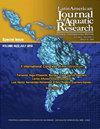2001-2018年智利中部用刺网捕获的智利鳕鱼(Merluccius gayi gayi)平均大小的影响因素
IF 0.8
4区 农林科学
Q3 FISHERIES
Latin American Journal of Aquatic Research
Pub Date : 2023-02-28
DOI:10.3856/vol51-issue1-fulltext-2904
引用次数: 0
摘要
智利鳕鱼是智利中部最重要的底层资源之一,其渔业涉及一支主要使用刺网的手工船队。在最近的渔业史上,渔获物的大小一直在减少,网目的大小也在逐渐减少。本研究旨在分析2001年至2018年间影响智利鳕鱼平均捕获量的因素,以了解这种情况,并将渔民的反应与所用渔网的捕获效率联系起来。应用广义线性模型,观察到年份、港口(区域)和网格大小等因素对捕获个体的平均大小的显著影响。该模型解释了85%的偏差,最大的相对贡献是年份(53.6%)和港口(30.2%)因素。网格尺寸因素的影响较小,偏差为1.2%。这些发现表明,网眼尺寸的逐渐减少与对种群人口结构变化的反应有关。考虑到估计的差异,可以在渔业中考虑按区域采取差异化管理措施。本文章由计算机程序翻译,如有差异,请以英文原文为准。
Factors that affect the mean size of Chilean hake (Merluccius gayi gayi) caught with gillnets in 2001-2018 in central Chile
Chilean hake (Merluccius gayi gayi) is one of central Chile's most important demersal resources, and its fishery involves an artisanal fleet that mainly uses gillnets. In the recent history of the fishery, there has been a decrease in catch sizes and a progressive reduction in mesh sizes. This study aimed to analyze the factors that influenced the mean catch sizes of Chilean hake between 2001 and 2018 to understand this situation, correlating the response of fishermen with the capture efficiency of the nets used. Applying a generalized linear model, a significant effect of the factors year, port (zone), and mesh size were observed on the mean size of individuals caught. The model explained 85% of the deviation, the greatest relative contributions being made by the factors year (53.6%) and port (30.2%). A lower effect was estimated for the mesh size factor with 1.2% deviance. These findings suggest that the progressive reduction in mesh sizes is associated with a response to the demographic change in the stock. Differentiated management measures by zones could be considered in the fishery, given the estimated differences.
求助全文
通过发布文献求助,成功后即可免费获取论文全文。
去求助
来源期刊

Latin American Journal of Aquatic Research
FISHERIES-MARINE & FRESHWATER BIOLOGY
CiteScore
1.70
自引率
10.00%
发文量
44
审稿时长
4-8 weeks
期刊介绍:
Latin American Journal of Aquatic Research- LAJAR is the continuation of the journal Investigaciones Marinas (1970-2007) and is published since 2008 by the Escuela de Ciencias del Mar, Facultad de Ciencias del Mar y Geografía of the Pontificia Universidad Católica de Valparaíso. LAJAR is an “Open Access” journal that publishes in English language, original research articles, reviews and short communications on aquatic science, which contain the results of research conducted in aquaculture or in oceanic and coastal marine waters of Latin America.
The following topics are considered: Physical Oceanography, Chemical Oceanography, Marine Biogeochemistry, Marine Pollution and Toxicology, Marine Geology and Geophysics, Biological Oceanography, Fisheries and Aquaculture.
 求助内容:
求助内容: 应助结果提醒方式:
应助结果提醒方式:


